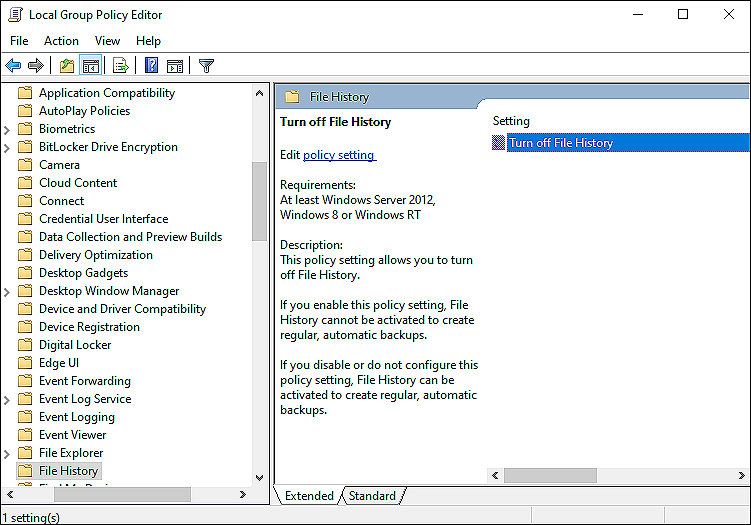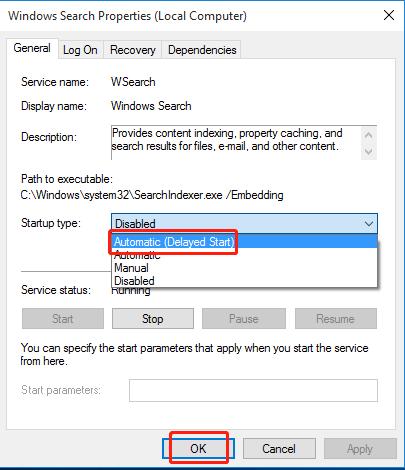
- #How to disable file history windows 10 how to#
- #How to disable file history windows 10 update#
- #How to disable file history windows 10 windows 10#
- #How to disable file history windows 10 windows 8.1#
Standard warning: Registry Editor is a powerful tool and misusing it can render your system unstable or even inoperable.
#How to disable file history windows 10 how to#
RELATED: How to Backup and Restore the Windows Registry
#How to disable file history windows 10 windows 10#
If you have Windows 10 Home, you can edit the Windows Registry to remove the OneDrive folder from the File Explorer’s left sidebar. You can also do it this way on Windows Pro or Enterprise, but the Group Policy Editor method is a better solution for cleanly disabling OneDrive. We recommend uninstalling OneDrive instead. RELATED: Using Group Policy Editor to Tweak Your PC Home Users: Remove the OneDrive Folder From File Explorer by Editing the Registry Update: You no longer have to edit your PC’s registry to do this on Windows 10 Home.
#How to disable file history windows 10 windows 8.1#
The “DisableFileSync” and “DisableFileSyncNGSC” registry settings that worked on Windows 8.1 no longer works on Windows 10. There doesn’t seem to be an associated registry setting you can modify to get the same effect as the group policy setting on Windows 10. To undo this change, just head back to here and change the policy to “Not Configured” instead of “Enabled.” Once you do, the empty OneDrive folder will vanish from File Explorer. If you see an empty OneDrive folder in File Explorer after changing this group policy setting, you’ll need to reinstall OneDrive from the Windows system folder. If you do, you’ll continue to see an empty OneDrive folder in File Explorer. You shouldn’t uninstall OneDrive from the Control Panel or Settings application if you use this method. This completely disables access to OneDrive. OneDrive will be hidden from File Explorer and users won’t be allowed to launch it. You won’t be able to access OneDrive at all, not even from within Windows Store apps or use the camera roll upload feature. Double-click the “Prevent the usage of OneDrive for file storage” policy setting in the right pane, set it to “Enabled,” and click “OK.” In the Local Group Policy editor’s left pane, drill down to Computer Configuration > Administrative Templates > Windows Components > OneDrive.

In Windows 10 Pro or Enterprise, hit Start, type gpedit.msc, and press Enter. If your work computer is part of a domain, it’s also likely that it’s part of a domain group policy that will supersede the local group policy, anyway. Also, if you’re on a company network, do everyone a favor and check with your admin first. It’s a pretty powerful tool, so if you’ve never used it before, it’s worth taking some time to learn what it can do. If you’re using Windows 10 Professional, Enterprise, or Education, the easiest way to disable and hide OneDrive is by using the Local Group Policy Editor.

Pro and Enterprise Users: Disable OneDrive with the Local Group Policy Editor However, if the empty OneDrive folder bothers you, you’ll need to use the below tricks.

OneDrive has been removed and is no longer doing anything. If you’re fine with that, you can stop now. There’s one problem with uninstalling OneDrive this way: The empty OneDrive folder will still appear in File Explorer’s sidebar. Double-click the “OneDriveSetup.exe” file here and Windows will reinstall OneDrive.) Just head to the C:\Windows\SysWOW64\ folder on a 64-bit version of Windows 10 or the C:\Windows\System32 folder on a 32-bit version of Windows 10. (If you ever want to reinstall OneDrive in the future, you’ll need to run the OneDrive installer buried in the Windows system folder. Windows will immediately uninstall OneDrive, and the OneDrive icon will disappear from the notification area.

Click it and click the “Uninstall” button. You’ll see a “Microsoft OneDrive” program appear in the list of installed software. Head to either Control Panel > Programs > Uninstall a Program or Settings > Apps > Apps & features. If you’re using Windows 10 Professional, Enterprise, or Education, skip this step and use the below Group Policy Editor method instead. Only Windows 10 Home users should do this. Starting in Windows 10’s Creators Update, you can now easily uninstall OneDrive like you would any other desktop program.
#How to disable file history windows 10 update#
RELATED: What's New in Windows 10's Creators Update


 0 kommentar(er)
0 kommentar(er)
